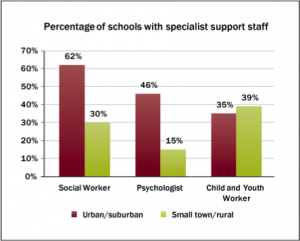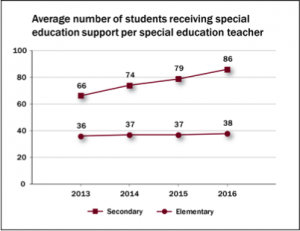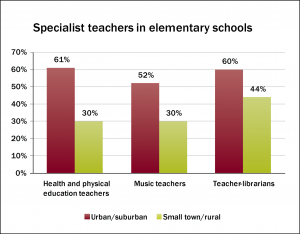New report reveals geographic divide in Ontario schools
Group releases 19th Annual Report on Ontario’s Publicly Funded Schools
For immediate release
Toronto (May 26, 2016) – Results from People for Education’s Annual School Survey raise significant questions about the impact of geography on students’ equitable access to education.
People for Education’s 2016 Annual Report on Ontario’s Publicly Funded Schools shows that students living in small towns, rural and northern communities are less likely to have music or health and physical education teachers, have less access to psychologists, and are more likely to attend schools that put caps on waiting lists for special education.
The report – based on survey results from 1154 elementary and secondary schools across Ontario – recommends a review of Ontario’s funding formula in order to address the inequities.
THE RURAL /URBAN DIVIDE
According to Andrea Walden, who operates a family farm in Thedford, Ontario, “As a society, we rely on farmers to feed our citizens. Failure to adequately educate students in rural communities is short-sighted, not only in relation to the personal situations of those families, but ultimately to the economic well-being of the province, as agri-business is a critical component of our economy.”
This year’s report examines differences between resources and programs in small town/rural schools compared to urban/suburban schools. Because most education funding is allocated according to enrolment, small town and rural boards – which are more likely to have smaller schools – may be at a disadvantage.
In 2016: 
- 61% of urban/suburban elementary schools have a health and physical education teacher, compared to 30% of small town/rural schools;
- 52% of urban/suburban schools have a music teacher, compared to 30% of small-town/rural schools;
- 60% of elementary schools in urban/suburban areas have a teacher-librarian, compared to 44% of small town/rural schools;
- 94% of urban/suburban secondary schools have a full-time guidance teacher, compared to 74% of small town/rural schools; and
- 62% of urban/suburban elementary schools have regular access to social workers, compared to 30% of small-town/rural schools.
IMPROVEMENTS IN HEALTH AND PHYSICAL EDUCATION
Over the past 10 years, the province has introduced a number of policies to support students’ physical and emotional health. This focus on students’ health appears to have had an impact on schools’ access to a range of specialists:
In 2016:
- 48% of elementary schools have a health and physical education teacher, a fairly steady upward trend from 40% in 2009.
- 50% of elementary and 76% of secondary schools have access to a regularly scheduled social worker, compared to 43% of elementary and 63% of secondary schools in 2012.
- 37% of elementary and 53% of secondary schools have access to a regularly scheduled child and youth worker, compared to 33% of elementary and 51% of secondary schools in 2012.
TEACHER-LIBRARIANS
There has been an ongoing decline in the percentage of schools with teacher-librarians over the past 15 years. The report points to evidence that teacher-librarians can help to foster important skills for student success, including information literacy, problem solving, communication skills, and critical thinking. These specialists can work directly with students and/or support classroom teachers in accessing education resources.
In 2016:
- Only 54% of elementary schools have a teacher–librarian, compared to 60% last year and 80% in 1998.
- The majority of elementary teacher-librarians are part-time, with only 10% of schools reporting a full-time teacher-librarian.
- 74% of secondary schools have a teacher–librarian.
SPECIAL EDUCATION FUNDING CHANGES
In 2014, the Ministry of Education began phasing in significant changes to the funding model to support students with higher special education needs. The changes have resulted in increases in special education funding in some boards and reductions in others. According to the report, the changes may result in improved access and better programs, but there is currently no information available about the impact of the changes.
In 2016: 
- an average of 17% of students in each elementary school and 27% of students in each secondary school receive some special education support.
- 26% of elementary schools report that not all students are receiving recommended special education support, an increase from 22% last year.
- 59% of elementary and 52% of secondary schools report that there are restrictions on the number of students they can place on waiting lists for assessments.
- The ratio of special education students to special education teachers is 38:1 in elementary schools and 86:1 in secondary schools.
Schools in small town/rural communities are further challenged in meeting students’ needs:
- 72% of small town/rural schools report restrictions on the number of students that can be placed on waiting lists for assessments, compared to 50% of schools in urban/suburban areas.
- Only 66% of small town/rural elementary schools have a full-time special education teacher, compared to 91% of urban/suburban elementary schools.
RECOMMENDATIONS
At a press conference in downtown Toronto, Doug Reycraft, former president of the Association of Municipalities of Ontario and a member of the Premier’s Community Hub Framework Advisory Group, said, “Our northern, small-town and rural communities are a part of the rich fabric that makes up Ontario. Perhaps it’s time to abandon the current funding formula in favour of a better system that comes closer to providing a fair and equitable level of funding for all students, wherever they live in Ontario. The formula works for cities; it doesn’t for small town and rural Ontario.”
According to Annie Kidder, Executive Director of People for Education, “The survey results raise the question: should the quality of a student’s education be determined by where they live? Ontario’s economy and future well-being requires a renewed commitment to those citizens who live outside urban areas. Students should have access to a rich education, whether they live in a rural farming community, a northern mining town, or in the heart of a big city.”
Among other things, the report recommends that:
- the Ministry of Education conduct an evaluation of the impact of the changes to special education funding; and
- the province work with school boards and communities to ensure that appropriate funding and policy is in place to provide all students with access to a wide range of learning opportunities—regardless of the size of their schools or their location.
For more information please contact People for Education: 416-534-0100

